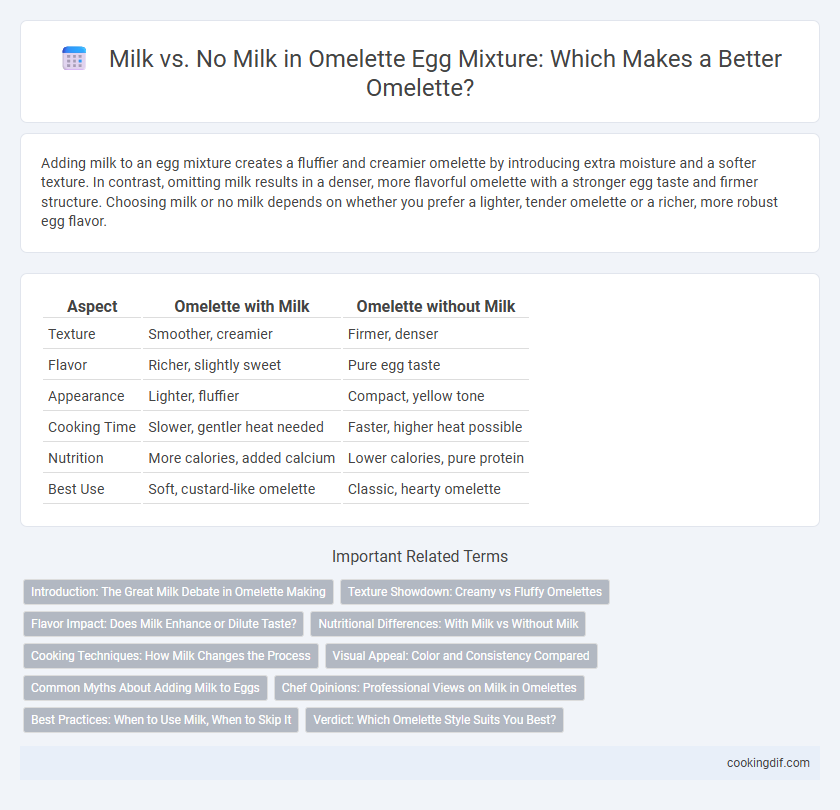Adding milk to an egg mixture creates a fluffier and creamier omelette by introducing extra moisture and a softer texture. In contrast, omitting milk results in a denser, more flavorful omelette with a stronger egg taste and firmer structure. Choosing milk or no milk depends on whether you prefer a lighter, tender omelette or a richer, more robust egg flavor.
Table of Comparison
| Aspect | Omelette with Milk | Omelette without Milk |
|---|---|---|
| Texture | Smoother, creamier | Firmer, denser |
| Flavor | Richer, slightly sweet | Pure egg taste |
| Appearance | Lighter, fluffier | Compact, yellow tone |
| Cooking Time | Slower, gentler heat needed | Faster, higher heat possible |
| Nutrition | More calories, added calcium | Lower calories, pure protein |
| Best Use | Soft, custard-like omelette | Classic, hearty omelette |
Introduction: The Great Milk Debate in Omelette Making
Adding milk to an egg mixture can change the texture and fluffiness of an omelette, as milk introduces moisture and fat, which may result in a softer, creamier consistency. However, omitting milk preserves the pure, rich egg flavor and produces a firmer, more traditional omelette texture. Studies show that the protein structure in eggs coagulates differently with and without milk, impacting the final omelette's density and mouthfeel.
Texture Showdown: Creamy vs Fluffy Omelettes
Adding milk to an egg mixture creates a creamy texture by increasing moisture and softening the proteins, resulting in a rich, custard-like omelette. In contrast, omitting milk produces a fluffy texture as the eggs set firmer and trap more air during cooking, leading to a lighter, more airy finish. The choice between milk and no milk directly impacts the omelette's mouthfeel and structural density, catering to personal texture preferences.
Flavor Impact: Does Milk Enhance or Dilute Taste?
Adding milk to an egg mixture can create a creamier texture but often dilutes the rich, savory flavor of the eggs, resulting in a milder taste. Pure egg mixtures without milk maintain a more intense, natural egg flavor that many chefs prefer for its depth and authenticity. Culinary experts note that omitting milk preserves the omelette's characteristic eggy aroma and allows additional ingredients like cheese and herbs to shine more distinctly.
Nutritional Differences: With Milk vs Without Milk
Adding milk to an omelette increases its calorie and carbohydrate content while slightly diluting protein concentration compared to using eggs alone. Milk contributes additional vitamins such as vitamin D and calcium, enhancing the nutritional profile of the omelette. Without milk, the egg mixture is higher in protein density and lower in sugar, making it a leaner option for those monitoring macronutrient intake.
Cooking Techniques: How Milk Changes the Process
Adding milk to an egg mixture for omelettes increases the liquid content, resulting in a softer, creamier texture due to the dilution of proteins and slower coagulation during cooking. Milk's fat and water content influence heat distribution, requiring lower heat and longer cooking times to prevent curdling and achieve a tender consistency. Omitting milk produces a denser, more structured omelette with faster cooking, as the higher protein concentration allows for quicker coagulation and a firmer texture.
Visual Appeal: Color and Consistency Compared
Adding milk to an omelette mixture results in a paler, softer texture and a more uniform, slightly creamy consistency, while omitting milk preserves a vibrant yellow color and a firmer, fluffier structure. Milk dilutes the egg proteins, leading to a less structured surface with smaller air pockets, whereas using only eggs enhances the natural golden hue and creates a more distinct, spongy texture. Visual appeal is influenced by these factors, with milk-based omelettes appearing smoother and lighter, and no-milk versions showcasing a bright, robust look.
Common Myths About Adding Milk to Eggs
Adding milk to eggs is often believed to make omelettes fluffier, but scientific tests show it can actually dilute the egg proteins, leading to a denser texture. The myth that milk enhances creaminess overlooks that milk's water content can cause the eggs to cook unevenly and lose a smooth consistency. For a genuinely fluffy omelette, whisking eggs thoroughly without dairy results in better aeration and texture.
Chef Opinions: Professional Views on Milk in Omelettes
Professional chefs often debate the inclusion of milk in omelette mixtures, with opinions divided on its impact. Many chefs argue that adding milk can dilute the egg proteins, resulting in a softer but less flavorful omelette, while others appreciate the creaminess and fluffiness it imparts. Top culinary experts like Gordon Ramsay and Julia Child suggest using water or cream as alternatives to maintain texture without compromising taste.
Best Practices: When to Use Milk, When to Skip It
Adding milk to an omelette mixture can create a fluffier texture by increasing moisture and slightly diluting the egg proteins, making it ideal for a lighter, creamier omelette. Skip milk when aiming for a denser, richer flavor and a firmer texture, especially in classic French-style omelettes or when using high-quality eggs. For best results, use milk-based mixtures when cooking low and slow, and omit milk for quick-cooked, folded omelettes to retain maximum egg flavor and structure.
Verdict: Which Omelette Style Suits You Best?
Adding milk to an omelette mixture creates a fluffier, softer texture by diluting the eggs and increasing steam during cooking, whereas skipping milk results in a denser, more intensely egg-flavored dish with a firmer structure. Chefs and culinary experts often recommend milk for those who prefer a tender, lighter bite, while purists and those seeking a richer, more savory profile favor no milk. Ultimately, the best omelette style depends on personal preference for texture and flavor intensity, with milk yielding a delicate, creamy consistency and no milk delivering a robust, hearty experience.
Milk vs No Milk for egg mixture Infographic

 cookingdif.com
cookingdif.com